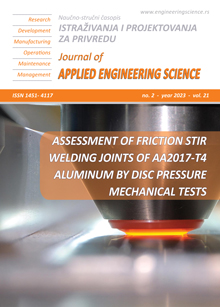THE FEASIBILITY OF IMPROVING CONCRETE STRENGTH PROPERTIES BY ADDING WASTE WOOD CHIPS
Abstract
This paper examines the ability to introduce an industrial waste product, wood chips, in concrete as a partial replacement for fine aggregate. Water was used to treat the wood chips before mixing to prevent them from soaking up the cement hydration water. The research presented in this paper aims to determine the impact of different treatment methods. The first method uses cement paste, and the second is sodium silicate. Twelve trial mixtures were prepared and cast employing water-cement ratios of 0.44 at various replacement levels of wood chippings. Fresh concrete properties tested inclusive slump test. Hardened concrete properties tested inclusively flexural strength, splitting tensile strength, compressive strength, and unit weight. Test results show that the lightening of concrete by wood shavings decreases the strength properties and the unit weight. On the other hand, the value of the slump test increased depending on the level of replacement of wood shaving. The most acceptable mixture and less reduction in the strength properties have been shown at MC10. The results of the tests demonstrate that the disposal of wood chips in concrete is practical and appropriate.
References
Bashar S. M.S, Abdullahi M., Hoong C.K. (2014) Statistical models for concrete containing wood chipping as partial replacement to fine aggregate. Construction and Building Materials 5513–19. DOI: 10.1016/j.conbuildmat.2014.01.021
Bederina M, Laidoudi B, Goullieux A, Khenfer MM, Bali A, Queneudec M. (2009) Effect of the treatment of wood shavings on the physico-mechanical characteristics of wood sand concretes. Construction and Building Materials 23(3):1311–1315. DOI: 10.1016/j.conbuildmat.2008.07.029
M Drdlová, M Popovič, M Šebík. (2018) The behavior of cement-bonded wood-chip material under static and impact load. International Conference Building Materials, Product and Technologies 379 .012025., DOI:10.1088/1757-899X/379/1/012025
Sharba A.A, Hason M.H, Hanoon A.N, Qader D.N, Amran e,f M, Abdulhameed A.A, Al Zand.A.W (2022) Push-out test of waste sawdust-based steel-concrete – Steel composite sections: Experimental and environmental study. Case Studies in Construction Materials 17. e01570. DOI: org/10.1016/j.cscm. 2022.e01570
Dias S., Tadeu, A.,Almeida, J., Humbert, P. António, J.de Brito, J. Pinhão, P. (2022) Physical, Mechanical and Durability Properties of Concrete Containing Wood Chips and Sawdust: An Experimental Approach. Buildings 12.1277.DOI: 10.3390/buildings12081277
Coatanlem P, Jauberthie R, Rendell F. (2006) Lightweight wood chipping concrete durability. Construction and Building Materials 20:776–81. DOI: 10.1016/j.conbuildmat.2005.01.057
Fu, Qiuni; Yan, Libo; Ning, Ting; Wang, Bo; Kasal, Bohumil (2020) Behavior of adhesively bonded engineered wood – Wood chip concrete composite decks: Experimental and analytical studies construction and Building Materials 247:118578. DOI: 10.1016/j.conbuildmat.2020.118578
Sharba A.A. (2020) Effect of calcium carbonate treated crumb rubber and oil palm fruit fibre on the mechanical properties of mortar. Cement and Concrete Composites 881.012166. DOI: 10.1088/1757-899X/881/1/012166
Koohestani, B., Koubaa, A., Tikou, BelemT., Bussie`re, B., Bouzahzah,H (2016) Experimental investigation of mechanical and microstructural properties of cemented paste backfill containing maple-wood filler. Construction and Building Materials 121:222–228.
Lorenzo B., René Steiger, Simon Zweidler, Andrea F. (2017) Analysis of shear transfer and gap opening in timber-concrete composite members with notched connections Mater. Struct. 50:231–246.
Fu, Q.; Yan, L. Ning, T.; Wang, B. Kasal, B. (2019) Interfacial bond behavior between wood chip concrete and engineered timber glued by various adhesives. Construction and Building Materials. 238, 117743. DOI: 10.1016/j.conbuildmat.2019.117743
Mohammed BS, Foo WL, Abdullahi M (2014) Flexural strength of palm oil clinker concrete beams. Materials and Design 53:325–331, DOI: 10.1016/j.matdes.2013.07.041
M. Li, Khelifa M., Ganaoui M. El (2017) Mechanical characterization of concrete containing wood shavings as aggregates. International Journal of Sustainable Built Environment 6(2): 587-596, DOI:10.1016/j.ijsbe.2017.12.005
Sharba, A.A(2019) The Efficiency of Steel Slag and Recycled Concrete Aggregate on the Strength Properties of Concrete. KSCE Journal of Civil Engineering 23:4846–4851, DOI:10.1007/s12205-019-0700-3
Gil, Haveth; Ortega, Andrés; Pérez, Jhon (2017) Mechanical behavior of mortar reinforced with sawdust waste. Resources, Procedia Engineering 200.325—332, DOI: 10.1016/j.proeng.2017.07.046
Sharba, A.A.K., Ibrahim, A.J. (2020) Evaluating the use of steel scrap, waste tiles, waste paving blocks and silica fume in flexural behavior of concrete. Innov. Infrastruct. Solut. 5:94 DOI:10.1007/s41062-020-00341-8.
Guo, Aofei; Aamiri, Osama Bu; Satyavolu, Jagannadh; Sun, Zhihui (2019) Impact of thermally modified wood on mechanical properties of mortar. Construction and Building Materials. 208. 413-420, DOI: 10.1016/j.conbuildmat.2019.03.016
Taoukil D, El Bouardi A, Sick F, Mimet A, Ezbakhe H, Ajzoul T.(2013) Moisture content influence on the thermal conductivity and diffusivity of wood-concrete composite. Construction and Building Materials 48:104–15

